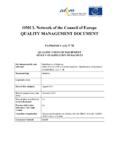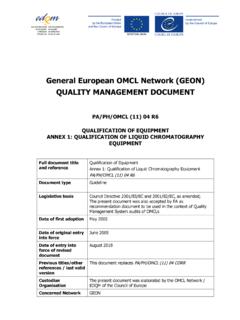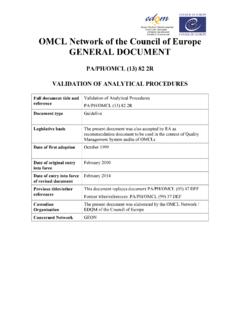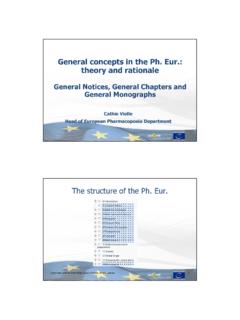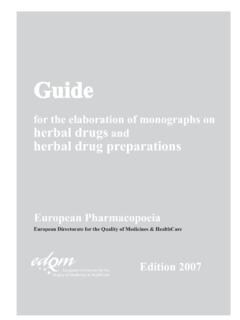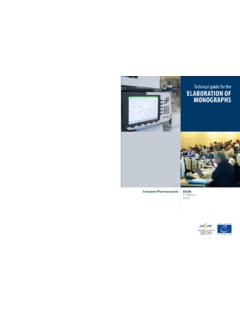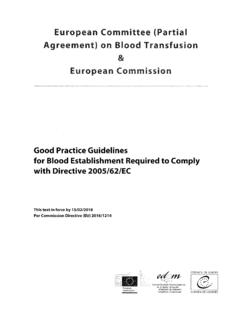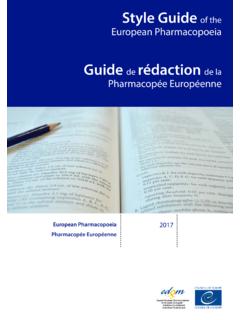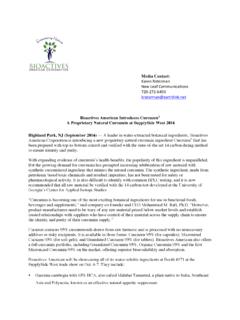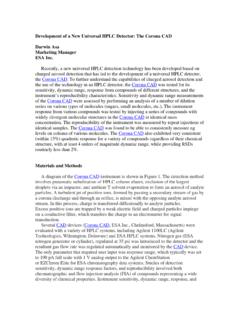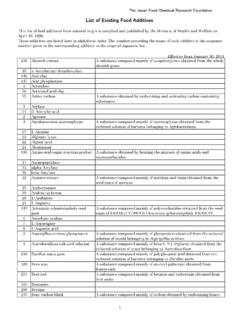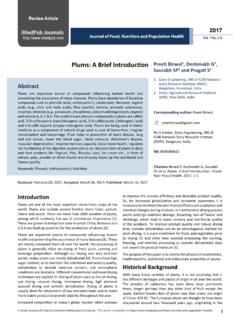Transcription of Comments concerning revised texts published in …
1 Pharmeuropa | Useful information | October 2017 1 Comments concerning revised texts published in Supplement following information details the technical modifications that have been made to revised texts adopted by the European Pharmacopoeia Commission at the March 2017 session and published in Supplement a text has been technically revised , this is indicated by horizontal or vertical lines in the margin of the supplement. The details given below complete this information, but are not necessarily following details can also be consulted in the Knowledge database under View ViscosityAlternative equipment: wording Loss on dryingEquipment qualification: the new sodium aminosalicylate dihydrate CRS replaces amoxicillin ArsenicMethod A: modified to avoid use of mercuric bromide paper; new method still relies on same chemical Nickel in hydrogenated vegetable oilsThe temperature programme of the graphite furnace may be different for each device, the text has been modified Water: semi-micro determinationEquipment qualification: the new sodium aminosalicylate dihydrate CRS replaces amoxicillin Water: micro determinationEquipment qualification: the new sodium aminosalicylate dihydrate CRS replaces amoxicillin PolyolefinsPhenolic antioxidants: due to the instability of plastic additive 12 CRS in the solvent mixture, it has been indicated to prepare the concerned solutions immediately before Pharmeuropa | Useful information | October Polyethylene with additives for containers for parenteral preparations and for ophthalmic preparationsPhenolic antioxidants.
2 Due to the instability of plastic additive 12 CRS in the solvent mixture, it has been indicated to prepare the concerned solutions immediately before Polypropylene for containers and closures for parenteral preparations and ophthalmic preparationsPhenolic antioxidants: due to the instability of plastic additive 12 CRS in the solvent mixture, it has been indicated to prepare the concerned solutions immediately before Pharmacopoeial harmonisationInformation modified for 2 excipients and added for 2 Names of herbal drugs used in traditional Chinese medicineTable updated to include new monographs published in Supplement FORMSC apsules (0016)Gastro-resistant capsules: possible ways to produce gastro-resistant capsules clarified. Preparations for inhalation (0671)The following changes have been made in order to align with the EMA Guideline on the Pharmaceutical Quality of Inhalation and Nasal : delivered dose indicated on label; indication of pre-metered dose only permitted with justification and approval by the competent preparations for nebulisation: addition of uniformity metered-dose preparations for inhalation: addition of leak rate powders: wording changed to pre-metered and device-metered inhalers.
3 The following additional changes have also been : instructions for uniformity of delivered dose testing (intra- and inter-inhaler testing) to be converted into vapour: definition harmonised with dosage forms covered in Standard Terms. Pharmeuropa | Useful information | October 2017 3 HERBAL DRUGS AND HERBAL DRUG PREPARATIONSA rtichoke leaf (1866)Assay: artichoke leaf dry extract HRS introduced for system suitability test; resolution requirement replaced by peak-to-valley ratio between chlorogenic acid and cryptochlorogenic leaf dry extract (2389)Assay: description of the column changed; peak eluting immediately after chlorogenic acid identified as cryptochlorogenic acid and described as such in the peak-to-valley ratio (1386)Definition: content limits : statement on polymorphism : method of sample preparation no longer specified; recrystallisation procedure added since substance shows substances: LC revised to reflect impurity profiles of products available on European market.
4 Limits modified and 1 additional specified and 5 additional unspecified impurities now controlled by revised : section butylated methacrylate copolymer (1975)Definition: relative molecular mass updated following development of a more accurate size-exclusion chromatography method in place of viscometry, which was used during elaboration of the alcohol (0256)This monograph has been revised to indicate its status within the context of International Harmonisation, a collaboration between the Japanese Pharmacopoeia, the United States Pharmacopeia and the European Pharmacopoeia. A footnote has been included in the text to refer to chapter Pharmacopoeial calcium (0886)This monograph has been revised to indicate its status within the context of International Harmonisation, a collaboration between the Japanese Pharmacopoeia, the United States Pharmacopeia and the European Pharmacopoeia. A footnote has been included in the text to refer to chapter Pharmacopoeial addition, modifications made to align to document signed by the Pharmeuropa | Useful information | October 2017 Cefixime (1188)Related substances: updated to include statement that solutions are to be prepared immediately before use and a refrigerated autosampler at 4 C is to be : updated to use dimethylformamide R as the solvent for sample : symmetry factor of maximum introduced for the peak due to diacetate (0657)Identification: the 2nd identification series has been updated and consists of a new TLC method and the reaction of dihydrochloride (0659)Identification: the 2nd identification series has been updated and consists of a new TLC method and the reaction of (1651)Related substances: quantity of clarithromycin for peak identification CRS used in reference solution (d) reduced.
5 Volume of solution reduced (0758)Identification: IR sample preparation deleted in accordance with current substances: specifications updated; impurity B (conformational isomer) excluded from the total; impurity G added as a specified : test 1 for injection (1506)Identification B: wording improved and blank chloride: colorimetric end-point determination replaced by potentiometry to avoid the use of potassium chromate (REACH Annex XIV).Dosulepin hydrochloride (1314)Identification B: IR sample preparation deleted in accordance with current substances: title of test modified; acceptance criterion for unspecified impurities introduced; Identification of impurities section added; name of CRS used for system suitability : section (0764)Identification: IR sample preparation deleted in accordance with current policy; 2nd identification series updated to avoid use of cobalt chloride (test D) and now consists of melting point and new TLC substances: GC replaced by core-shell LC : impurity B (1210)Characters: solubility in lipophilic solvent added.
6 Pharmeuropa | Useful information | October 2017 5 Identification: reference spectrum replaced by reference substances: more robust UHPLC method introduced; limits : end-point determination by colour indicator replaced by : transparency list citrate (1103)Characters: solubility in lipophilic solvent : reference spectrum replaced by reference substances: more robust UHPLC method introduced; limits : end-point determination by colour indicator replaced by : transparency list (0391)Identification: 2nd identification series updated to replace UV and chemical identification with acetate (0827)Characters: hygroscopic character of the powder : TLC test replaced by NMR and the test for amino acid analysis moved to this section in line with other peptide monographs; gonadorelin for NMR identification CRS introduced; tests A and B or tests A and C may alternatively be carried out, in accordance with current policy; the methods to be used for hydrolysis and analysis in the amino acid analysis are presented in a more flexible manner as this test is now prescribed only for identification optical rotation: limits tightened based on current batch : non-specific test deleted as there is no added value compared to the other purity substances: gonadorelin for system suitability CRS and a system suitability criterion introduced; limits for specified and unspecified impurities, as well as a reporting threshold, also : semi-micro determination replaced by coulometric titration which uses a smaller amount of test endotoxins: test deleted as this aspect is now covered by the general monograph Substances for pharmaceutical use (2034) in line with the European Pharmacopoeia policy on bacterial endotoxins in substances for pharmaceutical use (February 2015).
7 Labelling: statement on the suitability of the substance for use in the manufacture of parenteral preparations added, in accordance with current : section chorionic (0498)Production: the requirements for viral safety have been updated and harmonised across monographs on urine-derived substances. The emphasis is placed on the production, the clearance of viruses by the manufacturing process, rather than on tests for specific viruses /6 Pharmeuropa | Useful information | October 2017viral antigens. A statement has been reintroduced to make it clear that the manufacturing process should be demonstrated to inactivate and/or remove extraneous agents. As stated in the general monograph Substances for pharmaceutical use (2034), the requirements of general chapter Viral safety apply to the manufacture of urine-derived (0615)Identification C: spraying solution replaced to improve substances: maximum daily dose higher than 2 g/day, therefore specifications : method replaced by LC used for related monohydrate (1226)Related substances: storage of HPLC vials at 5 C using a temperature controlled autosampler (1531)Related substances: sample and solvent amounts : water-free formamide (2535)Characters: solubility in hexane replaced by less toxic solvent purity: hexane replaced by C: test deleted, as this impurity is now controlled by the LC for related G: LC test substances: new LC method introduced for the control of additional impurities.
8 Limits : section acetate (0933)Related substances: limit for impurity A chloride (1990)Definition: reference to pentamethyl-p-rosanilinium substances: former test for pentamethyl-p-rosanilinium and former related substances test merged in new related substances test; acceptance criterion for unspecified impurities introduced; Identification of impurities and Relative retention sections added; expression of limits : section updated to include pentamethyl-p-rosanilinium (impurity B).Metoclopramide (1348)Identification B: recrystallisation procedure added as substance shows C: reference solution now prepared without sulpiride E: retardation factors added. Pharmeuropa | Useful information | October 2017 7 Related substances: method modified to improve separation of impurities in reproducible order of elution; impurity limits updated; acceptance criterion for unspecified impurities introduced; reporting threshold updated in line with current : section hydrochloride monohydrate (0674)Title, Definition: degree of hydration B: IR sample preparation deleted in accordance with current C: previous TLC slightly E: former TLC for related substances used with some substances: TLC replaced by LC to control impurities A, B, C, D, F, G and : section (0049)Identification: 1st identification series updated and only IR now required; IR sample preparation deleted in accordance with current policy.
9 2nd identification series updated to avoid using potassium dichromate (test D) and only a mixed melting point now substances: new LC to take into account additional cetostearyl sulfate (0847)Water: sample size (1796)Content : upper limit for sucrose octasulfate increased to per cent; lower limit for aluminium decreased to per (2780)Related substances: limits for impurities D and E (0958)Production: the requirements for viral safety have been updated and harmonised across monographs on urine-derived substances. The emphasis is placed on the production, the clearance of viruses by the manufacturing process, rather than on tests for specific viruses /viral antigens. Such tests are no longer listed in the monograph and have been replaced by a statement which has been reintroduced in the Production section to make it clear that the manufacturing process should be demonstrated to inactivate and/or remove extraneous agents. As stated in the general monograph Substances for pharmaceutical use (2034), the requirements of general chapter Viral safety apply to the manufacture of urine-derived : the tests for hepatitis virus antigens and HIV antigen have been deleted.
10 The decision to test for certain viruses is made on a case-by-case basis, based on a risk assessment and depending on the viral safety measures already in place. Thus, the fact that tests for specific viruses are no longer included in the monograph should not be understood as a sign that such testing is not Pharmeuropa | Useful information | October 2017 Urokinase (0695)Production: the requirements for viral safety have been updated and harmonised across monographs on urine-derived substances. The emphasis is placed on the production, the clearance of viruses by the manufacturing process, rather than on tests for specific viruses /viral antigens. Such tests are no longer listed in the monograph and have been replaced by a statement which has been reintroduced in the Production section to make it clear that the manufacturing process should be demonstrated to inactivate and/or remove extraneous agents. As stated in the general monograph Substances for pharmaceutical use (2034), the requirements of general chapter Viral safety apply to the manufacture of urine-derived substances.

